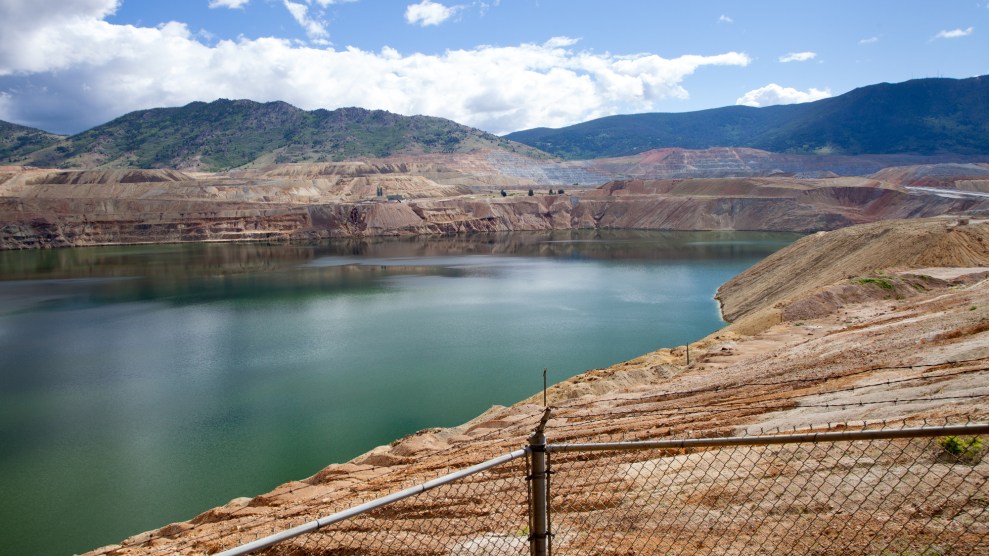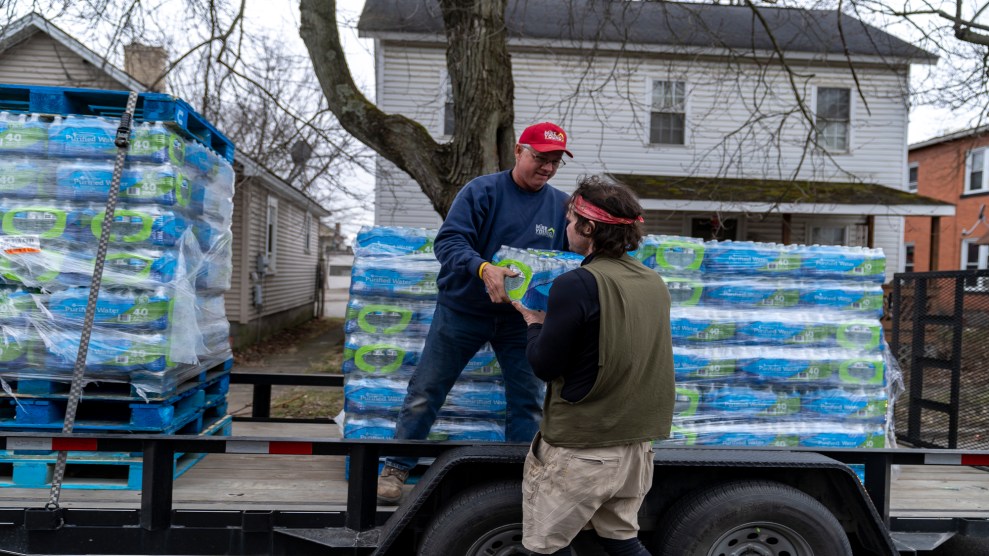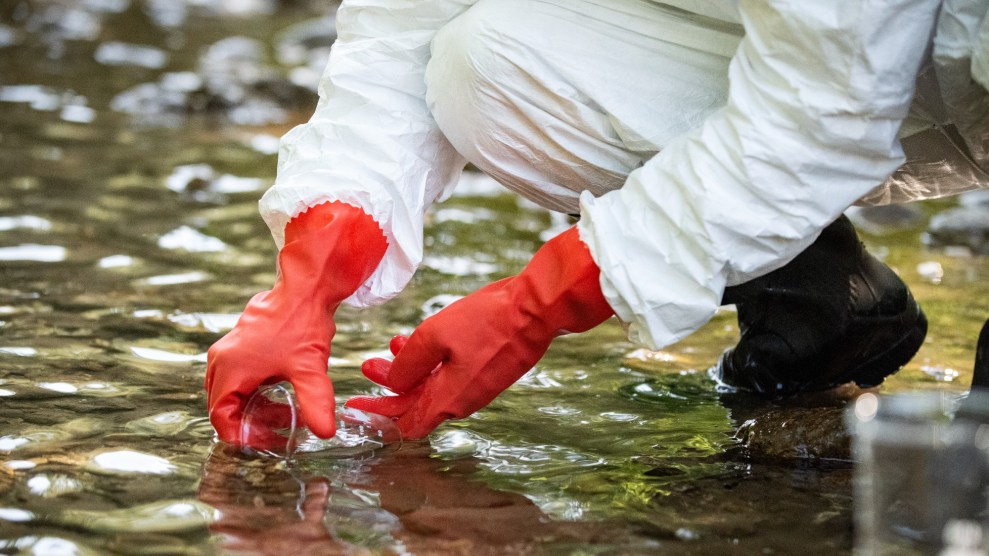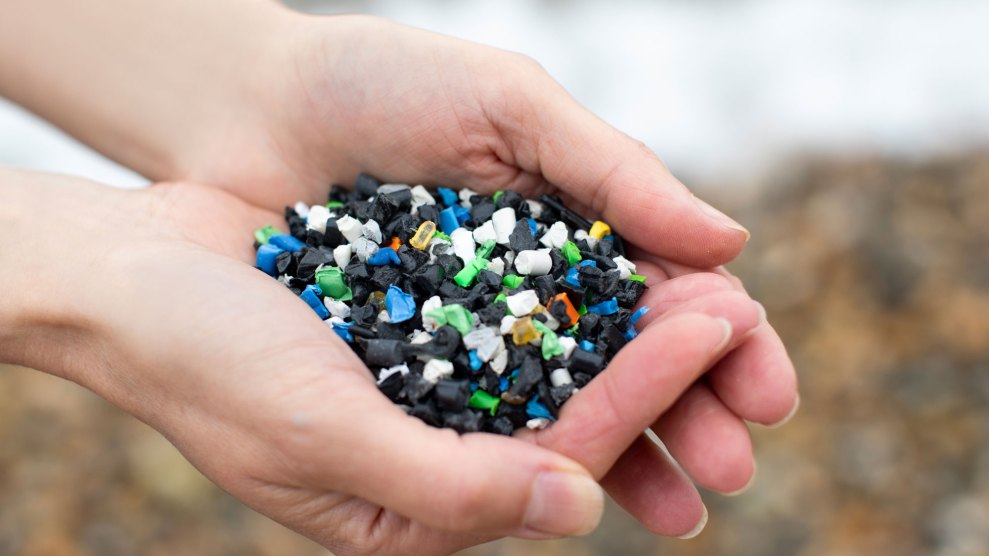
Flooded open-pit copper mine, Berkeley Pit, Butte, Montana, USA. Marli Miller/UCG/Universal Images Group/Getty
This story was originally published by High Country News and is reproduced here as part of the Climate Desk collaboration.
As darkness fell on Nov. 28, 2016, residents of Butte, Montana, heard the unmistakable honking of some 60,000 snow geese circling the Berkeley Pit, a defunct mine now flooded with toxic water. A snowstorm hit that night after an unusually warm autumn, and the geese, caught on a late journey from Canada to California, were forced out of the sky. They blanketed the surface of the water. Onsite staff tried to frighten them off, but an estimated 3,000 birds died.
Two companies—Atlantic Richfield Company (ARCO, now a British Petroleum subsidiary) and Montana Resources, which operates the still-active adjacent mine—are responsible for managing the pit, which is a Superfund site. They’d had procedures in place since 1996 to keep birds off the acidic water, which can kill some species within 12 hours. “Wailers” blasted obnoxious alarms year-round to discourage birds from landing; when they landed anyway, staff fired precision rifle shots at the water to scare them off. The measures were extremely effective: Of the thousands of ducks, geese, swans, grebes and more that landed briefly during spring and fall migrations, nearly all continued on. But the 2016 die-off exposed what engineers had overlooked: bird behavior. They didn’t know why or when birds might land in the first place, let alone how to predict another fluke event—a risk that is rising with climate change.
ARCO and Montana Resources were never fined for the die-off, but in 2017, they began pouring money into designing an arsenal of new tools to prevent a repeat. “They did what engineers do, and tried to find a technological way out,” said Mark Mariano, a restoration ecologist for Rampart Solutions, an environmental consulting firm. They also formed an advisory group of scientists and birders and hired Rampart Solutions; Mariano became the first ecologist to help update and implement the pit’s waterfowl protection plan. His team is bringing new expertise: “When you do try to engineer your way out of a problem, you need to understand waterfowl ecology first.”
Some proposed solutions were easily dismissed, even before taking biology into account. The pit—a mile long by a mile and a half wide and surrounded by steep walls—was too big to stretch a net across, dye a bird-deterring hue, or cover in tiny floating balls, a proposal mine staff said would cost $70 million and require building a custom factory in Butte. But the alternatives they developed also had critical flaws. Engineers tested a propane cannon mounted on an automated drift boat, but it moved too slowly to scare birds.
They tried automated lasers and considered lighting a laser net above the water, but that risked trapping birds underneath—and breaking federal aviation law, if a beam strayed into the nearby airport’s flight path. They tested a “vortex ring accelerator,” a truck-sized cannon that shot bird-deterring 200 mph air blasts across the pit, but that ended after the machine caught fire. They even designed fleets of water-borne and aerial drones—but they proved largely useless in bad weather, when migrating waterfowl are most likely to land.
“The parties had been trying to do the right thing, and they just didn’t really know how to do it,” Mariano said. Instead, he taught miners—who do most of the hazing—about birds. Identification matters: Some species dive instead of fly when startled, so it’s best to leave them alone. Mariano also started tracking wind and weather conditions—factors that trigger migration for many species.
Mariano now uses weather reports to predict when large flocks of snow geese might fly over Butte, so staff can use deterrents and have more hazers on site. Snow geese behavior is particularly relevant, because that species is most likely to die on the pit en masse: They arrive in huge flocks, exhausted. Mariano’s colleague, Bailey Tasker, also a restoration ecologist, is now using years of snow geese flight data collected by the U.S. Geological Survey to understand migration triggers and build a more finely tuned forecast. Tasker’s research may break ground in other areas, too: She hopes it could help answer long-standing questions, such as whether birds can intuit incoming weather.
All of this will help the mine develop new tools and make better use of existing ones. AI technology, for instance, which mine contractors are developing, could help spot and identify birds on the pit. And a fleet of drone boats, which are limited mostly by battery life, might be useful in storms after all; a precisely timed deployment could prevent a forecast flock from landing.
“I use the analogy all the time of a hurricane,” Mariano said. “You can’t stop a hurricane. But if you know one’s coming, you usually fare a lot better. You can be prepared. You can throw everything you got at it.”















